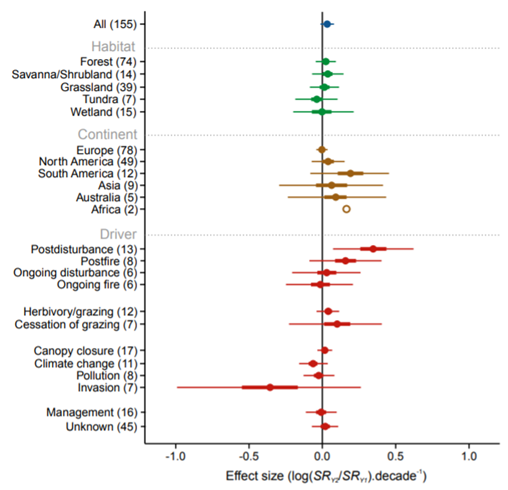Searching for the Right Shade of Green
December 31, 2021 | By Ben Colón-Emeric TD ‘22
Everywhere along the paths of Trail Wood wildness seems near at hand. But nowhere else do we feel so remote from the world as here beside this woodland brook as it traces its serpentine course among the mosses and ferns and trees. So wild does this setting seem that one August day I even brought along an aluminum pie tin and at the little gravel bar above the ford panned for gold.
– Edwin Way Teale, “A Naturalist Buys an Old Farm”
Naturalist Edwin Way Teale wrote these words to describe a small wetland area now known as Hampton-Teale wetland. This lovely prehistoric wetland was the “center of interest” to him in a plot of land he had purchased for its loveliness and naturalness. There was just one problem: the wetland was not quite as he thought. What began as a meadow was transformed into a pond by a small colonial dam. The metamorphosis to a shallow wetland was completed by railroad construction that filled the pond with sediment. The pristine “little gravel bar” where he panned for gold was, in fact, composed of waste from railroad excavations and largely filled with cinder and coal. Hampton-Teale wetland demonstrates a problem: “naturalness” can be a tricky framework for evaluating ecosystems. As Thorson and Harris, the geologists who investigated the wetland put it, “Which is more important? Our intangible aesthetic perceptions, or the quantitative (but reductionist) measures we attempt to legislate and use?” [1]
Does a wetland created inadvertently by humans count as part of creation? Thorson and Harris conclude that the impossibility of consistently using “naturalness” or “originality” to determine the value of a site means that wetlands, and by extension all ecosystems, should be conserved for the ecological values they provide. “They must be conserved for the right reason.” [1] Who created Hampton-Teale wetland is thus irrelevant; its value stems from its inherent nature, not from its creator.
For an example of what this looks like, consider the 2020 paper “Cascading social-ecological costs and benefits triggered by a recovering keystone predator” by Gregr et al. The authors examine the ecological and economic effects of recovering populations of sea otters in the North Pacific. Sea otter presence, they found, increases total ecosystem biomass by 37%, which in turn provides an economic benefit of around 53.6 million Canadian dollars from a mixture of fishing, carbon sequestration, and ecotourism. [2]
Figure 1. Gregr et al. What sea otter conservation takes away in terms of direct catch is more than made up for by the secondary economic benefits.
This paper is an admirable demonstration of how to measure ecosystem services to quantitatively drive conservation priorities, but it suggests a problem. Sea otters are an incredibly easy species to justify conserving as they are both a keystone species and a highly adorable, charismatic species. The fact that this paper puts an economic and ecological “value” on the sea otter suggests that this could be done for other species, creating a potential problem. Once you start placing values on creation, what happens when some parts of creation aren’t as valuable?
As species are driven to extinction by human activities, a global biodiversity crisis has emerged. Surprisingly, however, a 2013 meta-analysis by Vellend et al. found that while global biodiversity may be in decline, local biodiversity is usually not. The authors examined data from over 16,000 plots in hundreds of studies worldwide and found that in most areas, local biodiversity is not in decline. [3]
Figure 2. Vellend et al. Most sites saw no net decrease in biodiversity. The only drivers that decreased biodiversity were climate change, pollution, and invasion. When a species vanishes without a trace, what is really lost?
The loss of biodiversity on a global level is explained by homogenization of habitats created by the replacement of endemic species with exotics. To further complicate matters, they also found that even areas that do lose species can lose up to 20% of their diversity before there are any effects on ecosystem function. [3] If a large number of species have negligible effects on total ecosystem function, how can we justify their conservation from an empirical perspective?
Intuitively, it feels right to value the originality of a species, protecting the original inhabitants of an ecosystem from exotic or invasive species that do not naturally belong there. Unfortunately, invasive species sometimes provide measurable benefits to ecosystem functions. A 2018 meta-analysis by Davidson et al. found that some invasive plant species actually increase key services in coastal wetlands. This effect was most pronounced in saltmarshes and mangroves, where invasion by functionally similar species caused an increase in soil carbon and plant biomass. [4] The former is a key ecosystem service while the latter is an indicator of ecosystem health.
Plants are not the only invasive species providing aid to ailing saltmarshes; some animals are getting in on the act as well. Saltmarshes on Cape Cod are under serious threat from herbivorous crabs, particularly Sesarna reticulatum. The natural predators of these crabs have been severely depleted by human overexploitation, allowing populations of these herbivorous crabs to grow unchecked and ravage salt marsh plants. The solution to this problem is being provided by an opportunistic invader. Carcinus maenas is a species of invasive crab that preys on smaller crustaceans. The arrival of Carcinus maenas has provided some much-needed top-down control on Sesarna reticulatum. This promotes increased growth in marsh plants, speeding up the recovery of this ecosystem. Human impacts have left the ecosystem in desperate need of predators and an invasive species has filled the hole.
Carcinus maenas is promoting ecosystem recovery; does it really matter that it didn’t originate in that ecosystem? Maybe the right way to preserve originality is to focus on maintaining the originality of the ecosystem as a whole rather than the individual species that make it up. And so we return to the original problem of Hampton-Teale Wetland’s unnatural history. Edwin Way Teale’s inability to distinguish between an ancient pond and the manmade collateral damage of railroad construction demonstrates the impossibility of using ecosystem originality as a universal conservation framework.
It seems that either way we turn, we encounter problems. Ecosystem and species originality, or “naturalness”, fails because it is not aligned with the needs of the environment in general and humans in particular. Measuring ecosystem services fails because it focuses exclusively on the effects of an ecosystem without taking into account the reasons why an ecosystem or species may be valuable as an end rather than as a means. The right conservation system needs to take what is best from both ideas. Hampton-Teale Wetland is not less valuable for being artificial. Saltmarshes filled with invasive weeds are not more valuable because they carry a higher concentration of carbon in their soil. We cannot treasure an ecosystem based on what we perceive about its originality or based on what we can measurably get out of it; we must treasure each ecosystem because we believe that its very existence carries value.
Evaluating our previous problematic examples with this framework yields a way forward. Hampton-Teale Wetland may not be in the state it occupied before humans came, but the combination of human impacts and natural recovery have produced a beautiful wetland worth conserving. Invasive plants in American saltmarshes may provide important benefits to carbon storage, but the species native to that ecosystem are inherently worth protecting. Because we have the ability to prevent the death of rare species from competitive exclusion, our conservation priorities should be aligned in that direction. The saltmarshes of Cape Cod are in desperate need of a predator to fill a niche left open by human overexploitation. Carcinus maenas may not be natural, but until there are natural predators to compete with it, it fulfills a key function. The most important conservation objective for that ecosystem should be the reduction of human impacts on native predator species, so that Carcinus maenas is no longer necessary for promoting ecosystem recovery.
The way is difficult, and there is no comprehensive guide to perfect prioritization. But the system by which we evaluate conservation must be based on love. When you approach conservation from a position of love, you approach it taking everything into consideration with the essential goal of being part of creation, rather than extracting benefits from it. Stewardship requires respect for creation as creation.
1. Thorson, Robert, Harris, Sandra. “How ‘Natural’ are inland wetlands? an example from the trail wood audubon sanctuary in Connecticut, USA.” Environmental Management 15 (1991): 675–687. https://doi.org/10.1007/BF02589626.
2. Gregr, Edward J., Villy Christensen, Linda Nichol, Rebecca G. Martone, Russell W. Markel, Jane C. Watson, Christopher D. G. Harley, et al. “Cascading Social-Ecological Costs and Benefits Triggered by a Recovering Keystone Predator.” Science 368, no. 6496 (2020): 1243-47. https://doi.org/doi:10.1126/science.aay5342.
3. Vellend, Mark, Lander Baeten, Isla H. Myers-Smith, Sarah C. Elmendorf, Robin Beauséjour, Carissa D. Brown, Pieter De Frenne, Kris Verheyen, and Sonja Wipf. “Global Meta-Analysis Reveals No Net Change in Local-Scale Plant Biodiversity over Time.” Proceedings of the National Academy of Sciences 110, no. 48 (2013): 19456-59. https://doi.org/10.1073/pnas.1312779110. https://www.pnas.org/content/pnas/110/48/19456.full.pdf.
4. Davidson, Ian C., Grace M. Cott, John L. Devaney, and Christina Simkanin. “Differential Effects of Biological Invasions on Coastal Blue Carbon: A Global Review and Meta-Analysis.” Global Change Biology 24, no. 11 (2018): 5218-30. https://doi.org/https://doi.org/10.1111/gcb.14426. https://onlinelibrary.wiley.com/doi/abs/10.1111/gcb.14426.






January 20, 2022 | By Timothy Han SM ‘22
On December 6, 2017, AlphaZero, a new chess program developed by Google, changed the world. AlphaZero made its world premier in a match against Stockfish, the most dominant algorithm in chess history. Ever since IBM’s DeepBlue defeated world champion Garry Kasparov in 1997, engines have reigned supreme over humans in the world of chess. Stockfish, the latest in a long line of formidable chess algorithms, could evaluate 70 million moves per second; AlphaZero could only manage 80,000. An open-source program that has been ceaselessly improved since its debut in 2004, Stockfish came armed with countless formulas, strategies, and even endgame sequences to plan for every contingency.